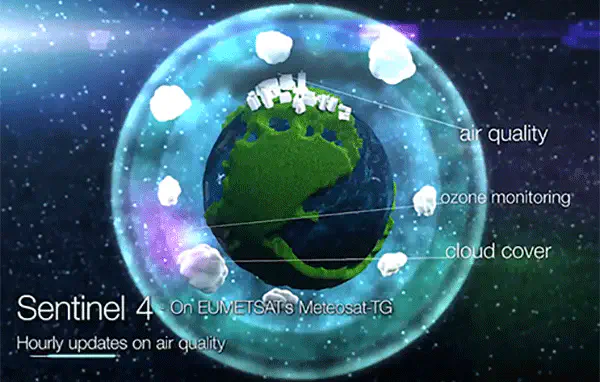
Optics for Sentinel-4
Reference project
Sophisticated materials. Unbeatable precision.
As part of the Copernicus program, a joint project of the EU and the ESA (European Space Agency), the Sentinel-4 satellite mission includes full monitoring of Europe and North Africa to collect high-precision real-time data on the composition of the atmosphere. Equipped with two high-resolution spectrometers, for which asphericon produced the optics, the satellite is scheduled to launch in 2022.
About Sentinel-4
Six sentinel missions, each lasting at least seven years, are being planned in order to obtain the most comprehensive view of the earth possible. Sentinel-1, for example, makes it possible to take pictures of floods on land or oil spills at sea and launched back in 2014. The Sentinel-4 mission will monitor the atmosphere and measure the level of air pollution. In contrast to the other Sentinel missions, which are independent satellites, Sentinel-4 and 5 are measuring instruments that are launched on other satellites. In the case of Sentinel-4, this will be the Meteosat Third Generation Sounder (MTG-S) satellite.
The two Sentinel-4 spectrometers will cover the entire spectral range from UV and visible to NIR wavelengths and provide measurements of greenhouse gases, nitrogen oxides, air quality, ozone, particles and solar radiation. Scanning is carried out from an altitude of around 36,000 kilometers.
Parameters & Objectives
- 45 subcontractors, including Jena-Optronik & asphericon
- Launch date: 2022 (Spectrometer 1), 2027 (Spectrometer 2)
- Understanding climate change
- Preventing natural disasters and ensuring civil security
 Abb. 1 Sentinel-4-Satellit, Flight time 8 years, altitude of satellite 36,000 k | © ESA - P.Carril
Abb. 1 Sentinel-4-Satellit, Flight time 8 years, altitude of satellite 36,000 k | © ESA - P.Carril
 Fig. 2 Objectives of the Sentinel-4 mission | © Airbus Defence Space
Fig. 2 Objectives of the Sentinel-4 mission | © Airbus Defence Space
Project realization
In order for measurements to be possible from such a long distance, measuring instruments and the associated optical components must be extremely precise. While the company Jena-Optronik designed the optical systems of the Sentinel-4 spectrometers, asphericon was responsible for production of the lenses. ESA’s order comprised 114 lenses, half aspheric and half spherical. In order to carry out clear spectral measurements, a spectral resolution of 0.12 to 0.5 nm is required for the optics. The lenses were manufactured at 20°C and are to be kept at the same temperature in orbit. They are made of calcium fluoride and silicon dioxide, which allows high accuracy but presented another challenge in production. Calcium fluoride in particular is characterized by its broad transmission spectrum from the ultraviolet to the infrared range, but also by its rather soft consistency. After intensive research and development work, asphericon succeeded in producing lenses from calcium fluoride which could be polished to a roughness of five angstroms.
Optics for Sentinel-4 at a glance:
- Development and production of lenses that can withstand extreme conditions in space
- Intensive development work and complex test procedures with sophisticated materials (e.g. CaF2)
- Aspherical and spherical lenses with diameters from 50 mm to 80 mm, a spectral resolution of 0.12 to 0.5 nm and angstrom polishing roughness values of 5 Å

